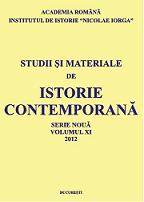Transilvania în planificarea postbelică britanică (1942-1946)
Transylvania in the British post-war planning (1942-1946)
Author(s): Mioara AntonSubject(s): History
Published by: Institutul de Istorie Nicolae Iorga
Keywords: Federation; the Second World War; the Soviet Union; British Post War Planning; Transylvania.
Summary/Abstract: During the years 1942-1943, Transylvania became the object of many analyses by the Foreign Research and Press Service, in which were formulated various scenarios for its post-war status. Most of them were focused on tracing an ethnic frontier between Romania and Hungary along with a population exchange; the partition of Transylvania and the autonomy of the Szekely districts linked to Hungary by a special corridor; the creation of a separate Transylvanian state as a member of a Danubian union, using the Swiss model; or the organization of an autonomous Transylvania as a buffer state between two federations or confederations expected to be established in Central and South-Eastern Europe after the war. The change in the course of the war forced the Foreign Research and Press Service to adapt the Transylvanian question to the strategic and military situation resulting after 1944. Consequently, the Soviet Union decided to annul the Vienna Award and restore the Trianon frontier.
Journal: Studii şi materiale de istorie contemporană (SMIC)
- Issue Year: 2012
- Issue No: 1
- Page Range: 54-68
- Page Count: 15
- Language: Romanian
- Content File-PDF

